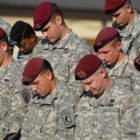August 25, 2011; Source: San Francisco Chronicle | Libya may or may not host a replay of the search for weapons of mass destruction (WMD) in Iraq after the fall of Saddam Hussein, but as in Iraq, Qaddafi’s ouster leaves huge caches of sophisticated weapons such as shoulder-fired anti-aircraft missiles unguarded, susceptible to being purchased or purloined and then sold on the black market. Already Libyan anti-aircraft missiles have been spotted on the black market in neighboring Mali. Reportedly, Qaddafi’s potential stockpile of chemical weapons is also a concern.
To be accurate, there is no evidence of WMDs in Libya and NATO surveillance of chemical weapons stockpiles suggests there has been no looting. But the collapse of the Qaddafi regime will unleash enough chaos to make the tens of thousands of missiles a lucrative “get-out-of-town” card for those Qaddafi loyalists who might, quite justifiably, feel at risk. At one point, Libya reportedly had 20,000 surface-to-air missiles, making them an attractive asset to insurgents in neighboring countries.
Sign up for our free newsletters
Subscribe to NPQ's newsletters to have our top stories delivered directly to your inbox.
By signing up, you agree to our privacy policy and terms of use, and to receive messages from NPQ and our partners.
The U.S. State Department has just made available $3 million to two international nonprofits, not named in this San Francisco Chronicle article, to identify sellers of major weapons and buy them back on the black market. Essentially, it is thought of as a practical measure to outbid potential terrorists for the weapons with ready cash. According to a spokesperson for the Arms Sales Monitoring Project at the Federation of American Scientists, buyback programs were very important in recovering hundreds of missiles from Afghanistan and Iraq.
One wonders about the side effects of this kind of program: whether it generates a market that basically enriches people who might well be Qaddafi regime supporters who are using the looted equipment to pay for their escapes to new lives in exile, and whether the U.S. money actually ends up bidding up the market prices of these weapons. But the support from the Federation of American Scientists and sources from the United Nations suggests that these buyback programs, when run through international nonprofits, do work.—Rick Cohen













